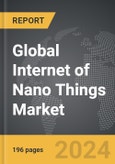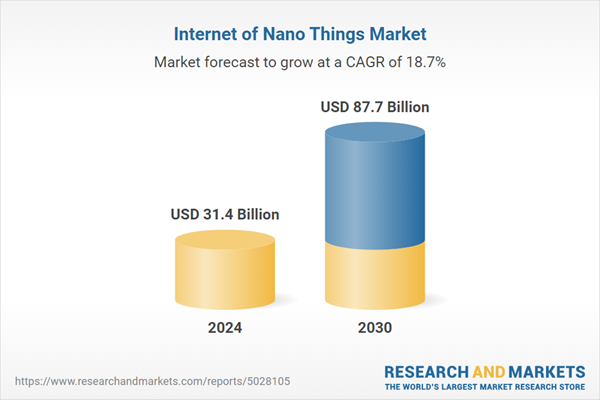The global market for Internet of Nano Things was valued at US$31.4 Billion in 2024 and is projected to reach US$87.7 Billion by 2030, growing at a CAGR of 18.7% from 2024 to 2030. This comprehensive report provides an in-depth analysis of market trends, drivers, and forecasts, helping you make informed business decisions. The report includes the most recent global tariff developments and how they impact the Internet of Nano Things market.
Segments: Product (Nano Sensors, Nano Phones, Nano Cameras, Nano Processors, Nano Memory Cards, Nano Power Systems, Nano Antennas & Transceivers, Other Products); Network Architecture (Nano-Nodes, Nano-Routers, Nano-Micro Interface Devices, Nano-Gateways, Other Network Architectures); End-Use (Healthcare & Life Sciences, Aerospace & Defense, Agriculture, Media & Entertainment, Transportation & Logistics, Other Applications).
Geographic Regions/Countries: World; United States; Canada; Japan; China; Europe (France; Germany; Italy; United Kingdom; and Rest of Europe); Asia-Pacific; Rest of World.
The analysts continuously track trade developments worldwide, drawing insights from leading global economists and over 200 industry and policy institutions, including think tanks, trade organizations, and national economic advisory bodies. This intelligence is integrated into forecasting models to provide timely, data-driven analysis of emerging risks and opportunities.
Global Internet of Nano Things Market - Key Trends & Drivers Summarized
What Is the Internet of Nano Things and Why Is It Pioneering a New Era of Connectivity?
The Internet of Nano Things (IoNT) refers to the integration of nanotechnology with the Internet of Things (IoT), creating a network of nanoscale devices that can collect, transmit, and process data at an unprecedented scale. This pioneering technology is ushering in a new era of connectivity by enabling the deployment of tiny sensors and devices that can monitor and interact with environments at the molecular or cellular level. IoNT has the potential to revolutionize industries such as healthcare, environmental monitoring, and defense by providing highly precise and localized data collection capabilities. For example, in healthcare, nanosensors could monitor patient health at the cellular level, enabling early detection of diseases and personalized treatment. As the capabilities of nanotechnology continue to advance, the Internet of Nano Things is poised to become a critical component of the future digital landscape.How Are Technological Advancements Shaping the Internet of Nano Things Market?
Technological advancements are significantly shaping the Internet of Nano Things market, particularly through innovations in nanoscale sensors, communication technologies, and energy harvesting. The development of nanosensors that can detect specific molecules, pathogens, or environmental changes is expanding the range of applications for IoNT, particularly in healthcare and environmental monitoring. Advances in communication technologies, including nanonetworks and molecular communication, are enabling the transmission of data at the nanoscale, overcoming the challenges of connecting such tiny devices to the broader internet. Additionally, the integration of energy harvesting technologies, such as nanoscale batteries and energy-scavenging systems, is addressing the power limitations of nanoscale devices, allowing them to operate independently for extended periods. These technological trends are driving the adoption of IoNT, as they enable the creation of more advanced and autonomous nanoscale networks that can operate in diverse and challenging environments.Why Is There an Increasing Demand for the Internet of Nano Things in Various Sectors?
The demand for the Internet of Nano Things is increasing across various sectors due to its potential to revolutionize data collection, monitoring, and interaction at the nanoscale. In healthcare, IoNT is being explored for its ability to enable precision medicine, where nanosensors can monitor patients' biological processes in real-time, allowing for early diagnosis and targeted treatment of diseases. The environmental monitoring sector is also driving demand for IoNT, as nanoscale sensors can detect pollutants, toxins, and other environmental changes with high precision, providing critical data for managing natural resources and addressing climate change. In the defense industry, IoNT is being developed for applications such as surveillance, where nanoscale devices can provide detailed intelligence in hostile or inaccessible environments. Additionally, the rise of smart cities and advanced manufacturing is creating new opportunities for IoNT, as these sectors seek to leverage nanoscale data for optimizing infrastructure, production processes, and resource management. As industries continue to explore the potential of nanoscale technology, the demand for the Internet of Nano Things is expected to grow.What Factors Are Driving the Growth in the Internet of Nano Things Market?
The growth in the Internet of Nano Things market is driven by several factors related to technological advancements, industry needs, and the expanding capabilities of nanotechnology. One of the primary drivers is the increasing demand for precision data collection and monitoring in industries such as healthcare, environmental management, and defense, where nanoscale sensors can provide insights that were previously unattainable. The ongoing development of communication technologies that can support nanoscale data transmission is also propelling market growth, as these innovations overcome the challenges of integrating nanoscale devices into larger networks. The push towards personalized medicine and advanced environmental monitoring is further driving demand for IoNT, as these applications require highly localized and real-time data collection. Additionally, the rise of smart cities, advanced manufacturing, and the broader IoT ecosystem is creating new opportunities for the integration of nanoscale devices, as these sectors seek to leverage the unique capabilities of nanotechnology for enhanced efficiency and optimization. As these trends continue to evolve, the Internet of Nano Things market is expected to experience sustained growth, driven by the need for more precise, efficient, and scalable connectivity solutions at the nanoscale.Report Scope
The report analyzes the Internet of Nano Things market, presented in terms of units. The analysis covers the key segments and geographic regions outlined below.Segments: Product (Nano Sensors, Nano Phones, Nano Cameras, Nano Processors, Nano Memory Cards, Nano Power Systems, Nano Antennas & Transceivers, Other Products); Network Architecture (Nano-Nodes, Nano-Routers, Nano-Micro Interface Devices, Nano-Gateways, Other Network Architectures); End-Use (Healthcare & Life Sciences, Aerospace & Defense, Agriculture, Media & Entertainment, Transportation & Logistics, Other Applications).
Geographic Regions/Countries: World; United States; Canada; Japan; China; Europe (France; Germany; Italy; United Kingdom; and Rest of Europe); Asia-Pacific; Rest of World.
Key Insights:
- Market Growth: Understand the significant growth trajectory of the Nano Sensors segment, which is expected to reach US$25.8 Billion by 2030 with a CAGR of a 20.3%. The Nano Phones segment is also set to grow at 19.2% CAGR over the analysis period.
- Regional Analysis: Gain insights into the U.S. market, valued at $9.1 Billion in 2024, and China, forecasted to grow at an impressive 18.1% CAGR to reach $13.5 Billion by 2030. Discover growth trends in other key regions, including Japan, Canada, Germany, and the Asia-Pacific.
Why You Should Buy This Report:
- Detailed Market Analysis: Access a thorough analysis of the Global Internet of Nano Things Market, covering all major geographic regions and market segments.
- Competitive Insights: Get an overview of the competitive landscape, including the market presence of major players across different geographies.
- Future Trends and Drivers: Understand the key trends and drivers shaping the future of the Global Internet of Nano Things Market.
- Actionable Insights: Benefit from actionable insights that can help you identify new revenue opportunities and make strategic business decisions.
Key Questions Answered:
- How is the Global Internet of Nano Things Market expected to evolve by 2030?
- What are the main drivers and restraints affecting the market?
- Which market segments will grow the most over the forecast period?
- How will market shares for different regions and segments change by 2030?
- Who are the leading players in the market, and what are their prospects?
Report Features:
- Comprehensive Market Data: Independent analysis of annual sales and market forecasts in US$ Million from 2024 to 2030.
- In-Depth Regional Analysis: Detailed insights into key markets, including the U.S., China, Japan, Canada, Europe, Asia-Pacific, Latin America, Middle East, and Africa.
- Company Profiles: Coverage of players such as Cisco Systems, Inc., Gemalto NV, IBM Corporation, Intel Corporation, Juniper Networks, Inc. and more.
- Complimentary Updates: Receive free report updates for one year to keep you informed of the latest market developments.
Some of the 46 companies featured in this Internet of Nano Things market report include:
- Cisco Systems, Inc.
- Gemalto NV
- IBM Corporation
- Intel Corporation
- Juniper Networks, Inc.
- Nokia Networks
- Qualcomm, Inc.
- SAP SE
- Schneider Electric SA
- Siemens AG
Tariff Impact Analysis: Key Insights for 2025
Global tariff negotiations across 180+ countries are reshaping supply chains, costs, and competitiveness. This report reflects the latest developments as of April 2025 and incorporates forward-looking insights into the market outlook.The analysts continuously track trade developments worldwide, drawing insights from leading global economists and over 200 industry and policy institutions, including think tanks, trade organizations, and national economic advisory bodies. This intelligence is integrated into forecasting models to provide timely, data-driven analysis of emerging risks and opportunities.
What’s Included in This Edition:
- Tariff-adjusted market forecasts by region and segment
- Analysis of cost and supply chain implications by sourcing and trade exposure
- Strategic insights into geographic shifts
Buyers receive a free July 2025 update with:
- Finalized tariff impacts and new trade agreement effects
- Updated projections reflecting global sourcing and cost shifts
- Expanded country-specific coverage across the industry
Table of Contents
I. METHODOLOGYII. EXECUTIVE SUMMARY2. FOCUS ON SELECT PLAYERSIII. MARKET ANALYSISCANADAITALYREST OF EUROPEREST OF WORLDIV. COMPETITION
1. MARKET OVERVIEW
3. MARKET TRENDS & DRIVERS
4. GLOBAL MARKET PERSPECTIVE
UNITED STATES
JAPAN
CHINA
EUROPE
FRANCE
GERMANY
UNITED KINGDOM
ASIA-PACIFIC
Companies Mentioned (Partial List)
A selection of companies mentioned in this report includes, but is not limited to:
- Cisco Systems, Inc.
- Gemalto NV
- IBM Corporation
- Intel Corporation
- Juniper Networks, Inc.
- Nokia Networks
- Qualcomm, Inc.
- SAP SE
- Schneider Electric SA
- Siemens AG
Table Information
| Report Attribute | Details |
|---|---|
| No. of Pages | 196 |
| Published | April 2025 |
| Forecast Period | 2024 - 2030 |
| Estimated Market Value ( USD | $ 31.4 Billion |
| Forecasted Market Value ( USD | $ 87.7 Billion |
| Compound Annual Growth Rate | 18.7% |
| Regions Covered | Global |









